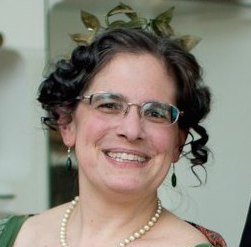Moving right along with late nineteenth-century variations from the usual pair of M. B. Gilbert (Round Dancing, Portland, Maine, 1890) and G. W. Lopp (La Danse, Paris, 1903), here’s a short one that’s classified as a redowa or mazurka. Lopp attributed La Rye to Gilbert, who had previously printed it in his own work without attribution. Gilbert did not ever credit himself specifically in his own book, unfortunately, which makes it difficult to be absolutely certain of the attribution.
The name of the variation suggests that it was meant to be danced to a musical setting of the famous Robert Burns poem, “Comin’ Thro’ the Rye“, which was set in both waltz and schottische rhythms (including both alternately in the Rye Waltz, a sequence dance dating back to at least the 1890s). The waltz version of the tune, which may be heard on this YouTube video, is not accented like a redowa or mazurka and does not offer especially good musical support to this sequence of steps. There may have been a version published with a more mazurka- or redowa-like style, but I haven’t been able to locate one. Skilled musicians might also be able to tweak it musically on the fly. It’s also possible that there was a completely different tune called “The Rye”, but I actually find this less likely, as the word was so strongly associated with a particular tune. There was a 1922 novelty dance (“The New Rye Dance”) published which combined a “redowa, Rye movement, and waltz” using “Comin’ Thro’ the Rye”, but that’s much too late to mean anything more than that people really liked adapting “Comin’ Thro’ the Rye” for dancing.
In the absence of adventurous musicians or a mazurka/redowa-accented recording of “Comin’ Thro’ the Rye”, I’d not really recommend that piece for these steps. They work much better with an appropriate polka mazurka or redowa tune. For tempo, Lopp offered his typical recommendation of 144 beats per minute, which works quite well and matches Gilbert’s overall recommendation for redowa/mazurka.
The dance itself is quite straightforward to reconstruct, with Gilbert and Lopp matching each other perfectly and no issues of interpretation. The gentleman starts with the left foot and his back to line of dance and the lady with her right, facing line of dance. The steps given below are the gentleman’s; the lady dances opposite. In effect, this means that she first dances the third and fourth bars below, followed by the first and second.
The Rye (four measures of 3/4)
1b Walk backward three steps left, right, left; angle slightly toward wall on last step
1b Slide right along line of dance on upbeat (&), close left to right (1); repeat twice more (&2&3), turning slightly to end with lady’s back to line of dance
1b Walk forward three steps right, left, right; angle slightly toward wall on last step
1b Slide left along line of dance on upbeat (&), close right to left (1); repeat twice more (&2&3), turning slightly to end with gentleman’s back to line of dance to repeat from the start
Notes
The Rye is surprisingly flat compared to others of its genre. The three steps along line of dance are specifically walking steps, not the running steps found in, for example, the New York and the Five-Step York. And the sideways travel is described as a series of steps and closures of the feet rather than cuts or displacements.
In dancing or teaching it, some attention needs to be paid to the transition from the running steps to the sideways slide, as there is some danger of carelessly slipping into a waltz movement (step-slide-close) if the turning begins too early, rather than three steps backward/forward. There should be about one-eighth of a turn on that last walking step, angling toward the wall. The transition through the rest of the quarter-turn into the side-steps then takes place smoothly between that step and the first sideways step.


Leave a Reply